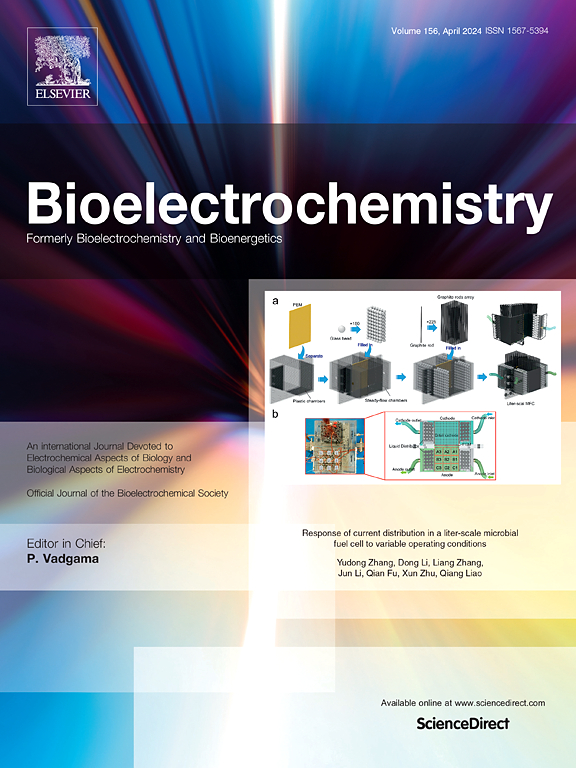Label-free electrochemical assessment of human serum and cancer cells to determine the folate receptor cancer biomarker
IF 4.8
2区 化学
Q1 BIOCHEMISTRY & MOLECULAR BIOLOGY
引用次数: 0
Abstract
The folate receptor (FR) is a well-known biomarker that is overexpressed in many cancer cells, making it a valuable target for cancer diagnostics and therapeutic strategies. However, identifying cancer biomarkers remains a challenge due to factors such as lengthy procedures, high costs, and low sensitivity. This study presents the development of a novel, cost-effective biosensor designed for the detection of FR. To overcome the limitations of traditional immunological methods, which rely on antigen–antibody interactions, we utilized a charge-based affinity approach. Folic acid (FA) was conjugated with poly (diallyl dimethylammonium chloride) (PDDA) using an EDC-NHS linker on the surface of multi-walled carbon nanotubes. The biosensor enabled electrochemical detection of FR through differential pulse voltammetry (DPV), achieving an impressive detection limit of 1.6 pg/mL and a dynamic range of 1–10,000 ng/mL. Additionally, the biosensor exhibited excellent stability (30 days), high selectivity, and repeatability (RSD = 3.14 %, n = 5). This work presents a promising strategy for developing ligand-receptor-based biosensors. It paves the way for future applications in cancer diagnostics and biosystem interfaces, offering high performance and practical advantages.

无标记电化学评价人血清和癌细胞中叶酸受体癌症生物标志物的测定。
叶酸受体(FR)是一种众所周知的生物标志物,在许多癌细胞中过表达,使其成为癌症诊断和治疗策略的有价值靶点。然而,由于程序漫长、成本高、灵敏度低等因素,识别癌症生物标志物仍然是一个挑战。本研究提出了一种新型的、具有成本效益的用于FR检测的生物传感器的开发。为了克服传统免疫学方法依赖抗原-抗体相互作用的局限性,我们利用了基于电荷的亲和方法。采用EDC-NHS连接剂在多壁碳纳米管表面将叶酸(FA)与聚二烯丙基二甲基氯化铵(PDDA)偶联。该生物传感器通过差分脉冲伏安法(DPV)实现了FR的电化学检测,检测限为1.6 pg/mL,动态范围为1-10,000 ng/mL。此外,该生物传感器表现出优异的稳定性(30天)、高选择性和可重复性(RSD = 3.14%, n = 5)。这项工作为开发基于配体受体的生物传感器提供了一个有前途的策略。它为癌症诊断和生物系统接口的未来应用铺平了道路,提供了高性能和实用的优势。
本文章由计算机程序翻译,如有差异,请以英文原文为准。
求助全文
约1分钟内获得全文
求助全文
来源期刊

Bioelectrochemistry
生物-电化学
CiteScore
9.10
自引率
6.00%
发文量
238
审稿时长
38 days
期刊介绍:
An International Journal Devoted to Electrochemical Aspects of Biology and Biological Aspects of Electrochemistry
Bioelectrochemistry is an international journal devoted to electrochemical principles in biology and biological aspects of electrochemistry. It publishes experimental and theoretical papers dealing with the electrochemical aspects of:
• Electrified interfaces (electric double layers, adsorption, electron transfer, protein electrochemistry, basic principles of biosensors, biosensor interfaces and bio-nanosensor design and construction.
• Electric and magnetic field effects (field-dependent processes, field interactions with molecules, intramolecular field effects, sensory systems for electric and magnetic fields, molecular and cellular mechanisms)
• Bioenergetics and signal transduction (energy conversion, photosynthetic and visual membranes)
• Biomembranes and model membranes (thermodynamics and mechanics, membrane transport, electroporation, fusion and insertion)
• Electrochemical applications in medicine and biotechnology (drug delivery and gene transfer to cells and tissues, iontophoresis, skin electroporation, injury and repair).
• Organization and use of arrays in-vitro and in-vivo, including as part of feedback control.
• Electrochemical interrogation of biofilms as generated by microorganisms and tissue reaction associated with medical implants.
 求助内容:
求助内容: 应助结果提醒方式:
应助结果提醒方式:


